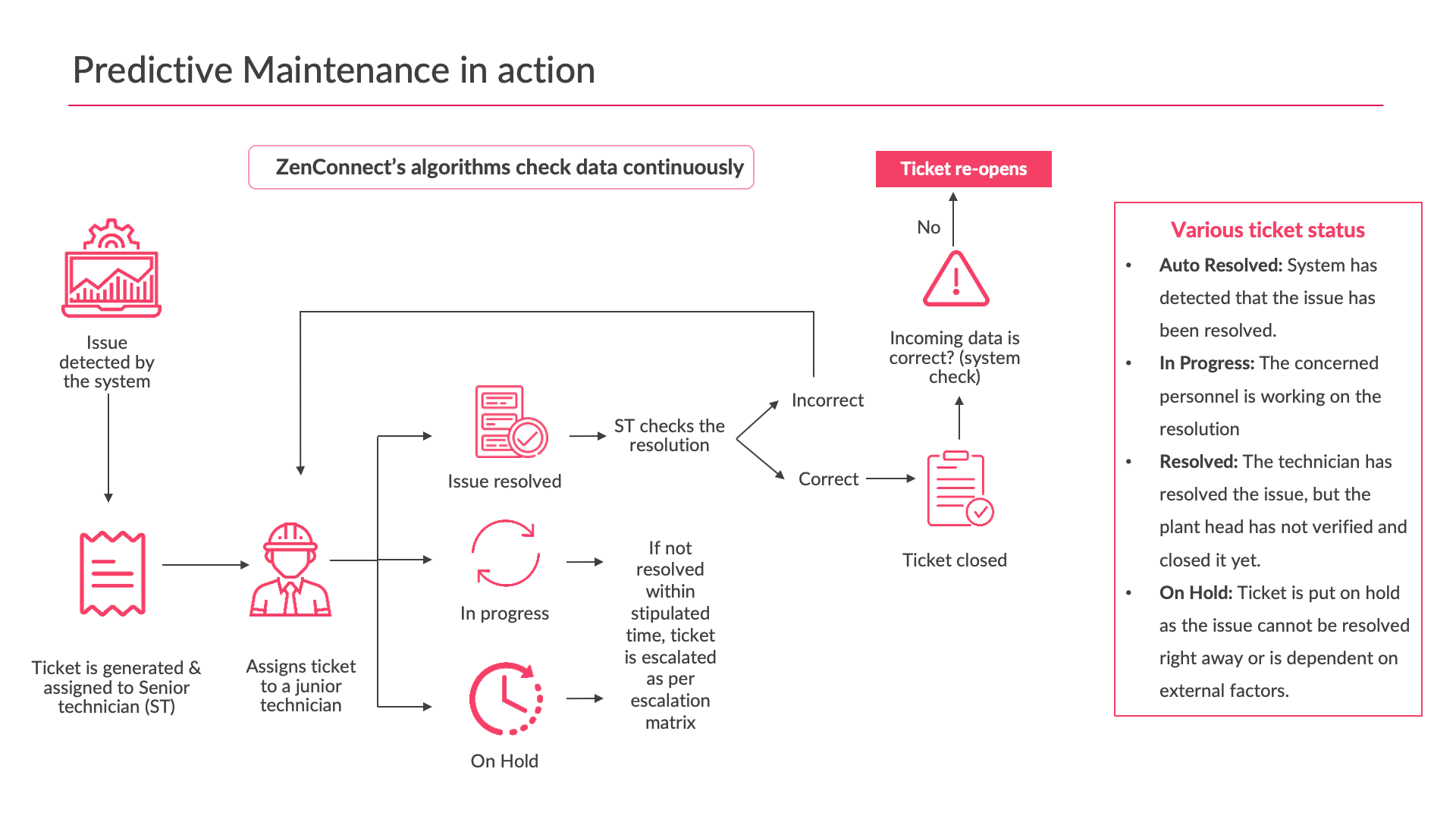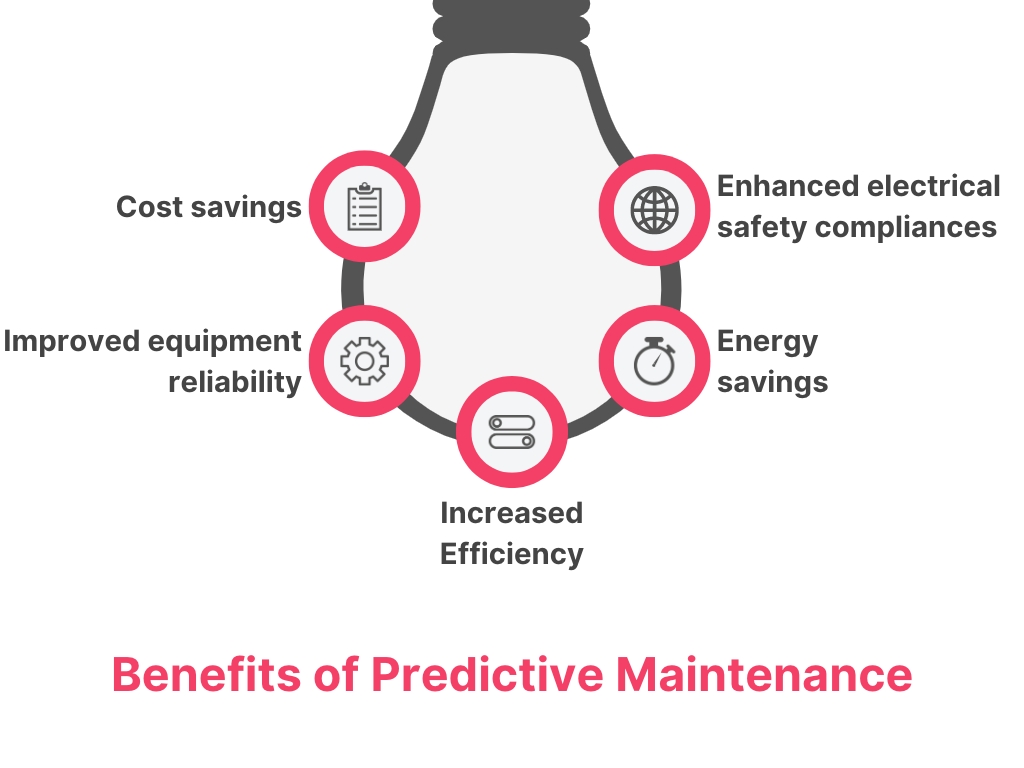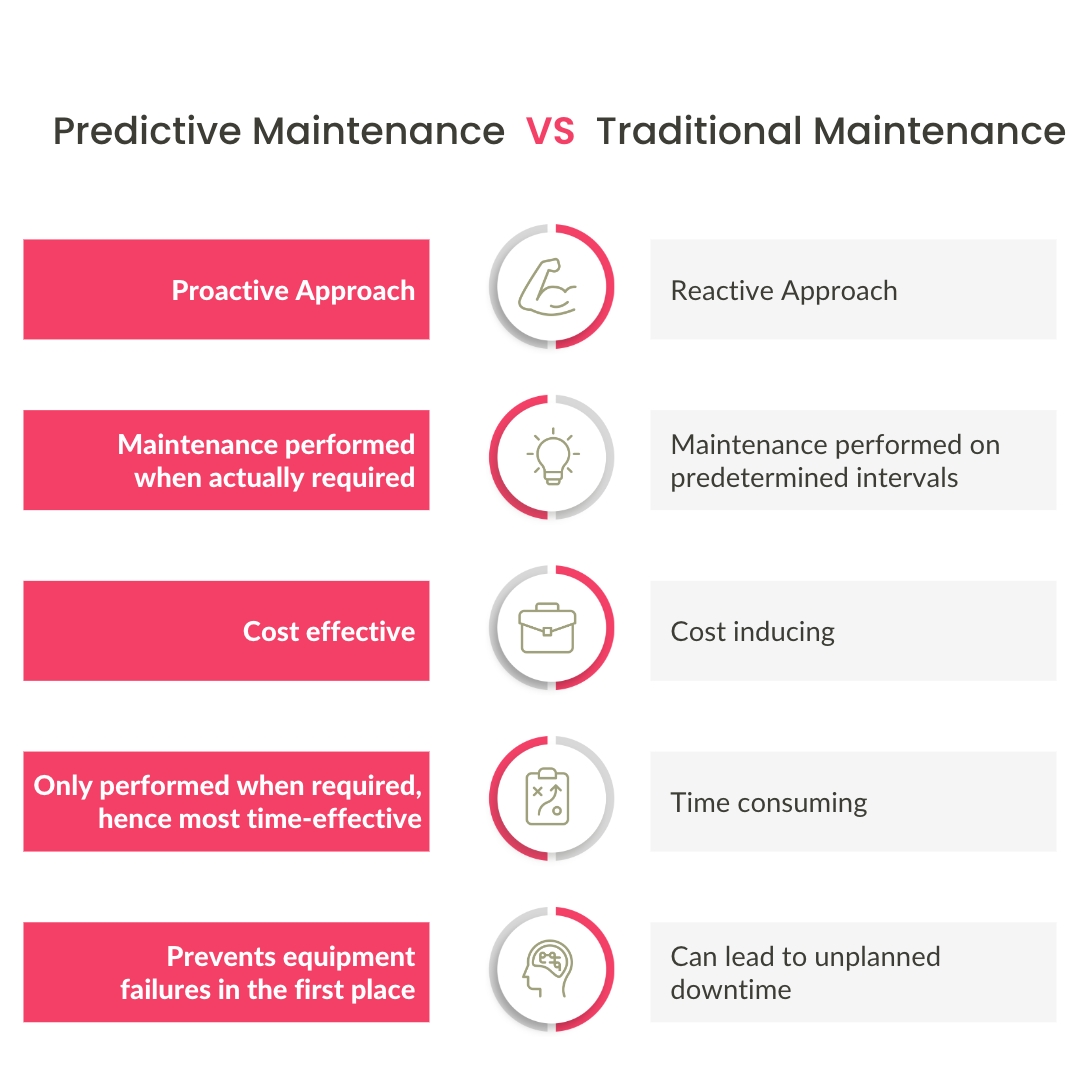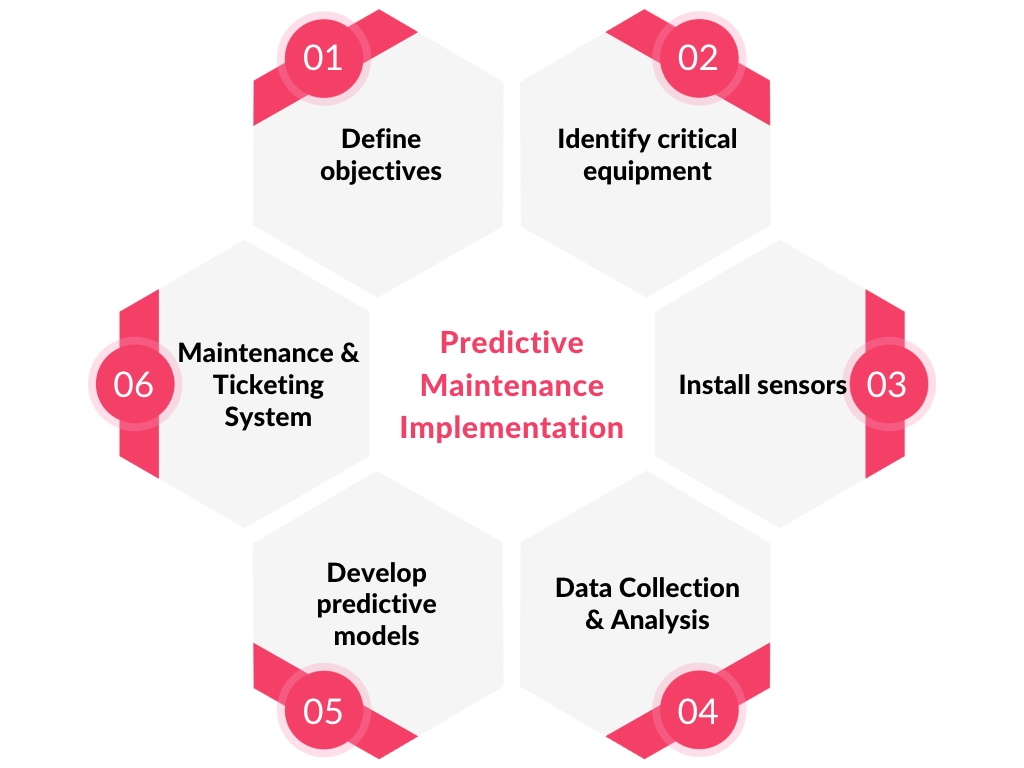In today’s fast-paced business environment, downtime can mean serious losses for any commercial building. The traditional method of reactive maintenance can be costly, inefficient and lead to unscheduled downtime. However, with the advancements in technology and the rise of IoT (Internet of Things), we have the ability to collect and analyze vast amounts of data, making it possible to move from reactive to predictive maintenance.
This comprehensive guide will explore the concept of predictive maintenance, its components, and how it can be applied to commercial buildings. The guide will also discuss the difference between traditional and predictive maintenance along with how an IoT-based energy and asset management solution can help you implement it in your buildings.
Table of Contents
ToggleWhat is Predictive Maintenance?
Predictive maintenance is a proactive approach to maintenance that uses data analysis, machine learning, and artificial intelligence to predict when equipment failure is likely to occur.
By monitoring equipment performance and analyzing data such as temperature, voltage and energy consumption, it can identify potential issues before they lead to downtime or equipment failure. This allows maintenance to be scheduled at a time that is most convenient and cost-effective, reducing maintenance costs, downtime, and improving equipment reliability.

Predictive maintenance is a step up from traditional maintenance approaches such as reactive or preventative maintenance. In reactive maintenance, equipment is only repaired or replaced after it has failed, resulting in costly downtime and emergency repairs. In preventative maintenance, equipment is regularly maintained or replaced at set intervals, regardless of whether it is actually needed, which can result in unnecessary maintenance costs.
Predictive maintenance takes a more data-driven approach, using sensors and other monitoring devices to collect data on equipment performance. This data is then analyzed using machine learning and artificial intelligence algorithms to identify patterns and anomalies that could indicate potential problems.
By identifying these issues before they result in failure, maintenance can be scheduled at a time that is most convenient and cost-effective, reducing downtime and improving equipment reliability.
By implementing it, companies can reduce maintenance costs by only performing maintenance when it’s actually needed, rather than at set intervals. They can also reduce downtime by identifying potential issues before they result in equipment failure.
Additionally, it can improve safety by identifying potential safety hazards before they become a problem.
Importance of Predictive Maintenance in commercial buildings
Predictive maintenance is becoming increasingly important in commercial buildings due to the growing use of advanced technology and automation systems.
Commercial buildings have a wide range of equipment and systems, including HVAC systems, refrigeration systems, elevators, lighting systems, and security systems, among others. These systems are critical to the functioning of the building and require regular maintenance to ensure they are working efficiently and effectively.
Predictive maintenance can be particularly beneficial for commercial buildings for several reasons:

1. Cost savings
Commercial buildings are often large and/or complex, with many systems and pieces of equipment that require maintenance. Traditional maintenance approaches can be time-consuming and expensive, as maintenance is performed either on a set schedule or in response to failures.
Predictive maintenance can help reduce these costs by identifying potential issues before they result in downtime or equipment failure, allowing maintenance to be scheduled at a time that is most convenient and cost-effective.
2. Improved equipment reliability
Commercial buildings rely heavily on several equipment and systems to operate effectively. Downtime due to equipment failures can be costly and disruptive.
Predictive maintenance can help improve equipment reliability by identifying potential issues before they become a problem. By addressing issues early, maintenance can be performed to prevent equipment failure and ensure the system is operating at peak efficiency.
3. Increased Efficiency
Another key benefit in commercial buildings is increased overall efficiency of the building. By proactively monitoring equipment and identifying potential issues before they lead to downtime or failure, it can help improve the overall efficiency of the building’s operations. This ensures that the building’s operations continue to run smoothly, without unexpected interruptions.
4. Energy savings
Commercial buildings are large consumers of energy, and energy costs can be a significant expense. Predictive maintenance can help identify equipment inefficiencies or malfunctions that can contribute to energy waste. By addressing these issues, energy consumption can be reduced, resulting in lower energy bills and a more sustainable building.
5. Enhanced electrical safety compliances
By implementing predictive maintenance, IoT-enabled smart energy meters continuously monitor various electrical safety parameters like voltage or current balance to detect potential electrical safety hazards before they cause damage or pose a safety risk.
Moreover, by identifying and addressing potential electrical hazards, predictive maintenance can help create a safer work environment for employees and building occupants.
Predictive Maintenance VS Traditional Maintenance
Traditional maintenance and predictive maintenance are two different approaches to equipment maintenance that have distinct differences in their methodologies and outcomes. Here’s a breakdown of the two approaches:

Traditional Maintenance
Traditional maintenance, also known as corrective maintenance or reactive maintenance, is a method of maintenance that is performed in response to equipment failure or when equipment reaches a predetermined interval for maintenance.
This approach involves following a maintenance schedule that is based on manufacturer recommendations or industry standards. Maintenance is typically performed on a regular basis, whether or not the equipment actually needs it, with the goal of preventing equipment failure.
While traditional maintenance can help prevent equipment failure to a certain extent, it has several limitations. For one, it can be costly and time-consuming, as maintenance is performed on a set schedule regardless of whether or not the equipment actually requires it.
Additionally, traditional maintenance can lead to unplanned downtime, as equipment failures can still occur between scheduled maintenance intervals.
Predictive Maintenance
Predictive maintenance, on the other hand, is a proactive approach to maintenance that relies on data to predict when maintenance is really needed. This approach involves continuously monitoring equipment to identify potential issues before they become a problem.
It uses various types of sensors, such as, temperature sensors, pressure sensors, energy meters etc. to collect data on equipment performance. This data is then analyzed using machine learning algorithms to identify patterns and anomalies that could indicate an impending equipment failure.
Its benefits are numerous. By proactively identifying potential issues, predictive maintenance can help reduce downtime and maintenance costs, while improving the overall reliability of the equipment.
Additionally, predictive maintenance can help extend the lifespan of equipment, reduce energy consumption, and improve safety by identifying potential electrical safety hazards.
Summing up the difference: while traditional maintenance can help prevent equipment failure to a certain extent, it has several limitations. Predictive maintenance, on the other hand, is a more proactive approach that relies on data to predict when maintenance is actually needed.
Industries that are adopting predictive maintenance
Predictive maintenance has been successfully implemented in a wide range of industries, including:
1. Hotels

Predictive maintenance is increasingly being used in hotels to monitor and maintain building systems, such as HVAC, lighting, refrigeration, etc. For example, a hotel may use it to monitor the health of its HVAC system and schedule maintenance before a breakdown occurs. This can help ensure that guests are comfortable at all times and that the hotel is running efficiently.
2. Retail

Predictive maintenance is also used in the retail industry to monitor and maintain critical assets & equipment used in supermarkets, quick-service restaurants (QSRs), and restaurants.
For example, a supermarket may use predictive maintenance to proactively monitor the health of refrigeration units and schedule maintenance when actually required to avoid any unforeseen breakdowns. This can help ensure that perishable items are kept at the right temperature and that customers are satisfied with their shopping experience.
3. Office buildings

Predictive maintenance is also being used in office buildings to monitor and maintain office building systems, such as HVAC, lighting, UPS, fire alarms, etc. For example, an office building may use predictive maintenance to keep the critical asset & equipment in perfect working condition to ensure that the occupants are comfortable and that the building is running at its peak efficiency.
4. Manufacturing

Predictive maintenance is widely used in manufacturing plants to monitor the health of equipment and predict when maintenance will be required to avoid unplanned downtime. By using predictive maintenance, manufacturing plants can reduce maintenance costs, increase equipment uptime, and improve overall productivity.
5. Warehouse

Predictive maintenance is increasingly being used in warehouses, especially cold storage ones to monitor and maintain mission critical equipment such as refrigeration systems, conveyor belts, automated storage & retrieval systems, etc.
For example, via temperature monitoring, compressor monitoring, motor monitoring, voltage monitoring, operators can proactively address maintenance needs before they turn into equipment failures, minimizing downtime and preventing spoilage of the stored goods. This helps to improve the efficiency and profitability of the warehouse.
6. Data centers

Predictive maintenance is also used in data centers to monitor and maintain critical equipment such as servers, storage systems, and cooling infrastructure to ensure the reliability of critical infrastructure and minimize downtime.
7. Healthcare

Predictive maintenance is also being applied in healthcare more broadly to improve the maintenance and reliability of medical equipment, facilities, HVAC, lighting, and other critical infrastructure.
Key components of Predictive Maintenance
Predictive maintenance involves several key components that work together to help organizations monitor the health of their equipment and schedule maintenance before a breakdown occurs. Here are some its main components:
1. Condition monitoring
This involves monitoring the condition of equipment to detect any changes that may indicate a potential failure.
2. Data collection and analysis
To effectively monitor equipment condition, data needs to be collected and analyzed. This involves collecting data from sensors installed on equipment or using data from other sources, such as maintenance records or historical performance data.
3. Machine learning and AI
Machine learning and artificial intelligence (AI) algorithms can be used to analyze data and identify patterns or anomalies that may indicate a potential failure. For example, machine learning algorithms can be trained to identify patterns in data that may indicate a bearing is starting to fail.
4. Predictive analytics
Predictive analytics involves using data analysis techniques to predict when a failure is likely to occur and schedule maintenance accordingly. This helps organizations avoid unplanned downtime and reduce maintenance costs.
5. Maintenance planning and scheduling
Once an issue or potential failure is identified, the maintenance team is alerted via digital ticketing system so that the issue can be resolved swiftly. The digital ticketing system also allows for issue tracking & escalation if required.
6. Performance tracking
Performance tracking involves monitoring the effectiveness of predictive maintenance strategies over time and making adjustments as needed.
Implementation of Predictive Maintenance
Implementing a predictive maintenance program involves several key steps:

1. Define objectives
The first step in implementing a predictive maintenance program is to define your objectives. What do you hope to achieve by implementing it? Are you looking to reduce downtime, increase efficiency, lower maintenance costs or all of the above?
Defining your objectives will help you determine what data you need to collect, what tools and technologies you need to use, and what metrics you will use to measure success.
2. Identify critical equipment
Once you have defined your objectives, the next step is to identify the critical equipment that you want to monitor. This may include equipment that is vital to your operations or equipment that is prone to failure.
3. Sensor installation
To monitor equipment, you will need to install sensors that can collect data on factors such as temperature, pressure, voltage etc. This may involve retrofitting existing equipment or installing sensors on new equipment.
4. Data collection & Analysis
Once the sensors are in place, you can begin collecting and analyzing data on equipment performance. This may involve using data analytics software, machine learning algorithms, or other tools to identify patterns and anomalies that may indicate a potential failure.
5. Develop predictive models
Based on the data you have collected, you can develop predictive models that can help you anticipate when maintenance is needed. These models may be based on factors such as equipment age, usage patterns, environmental conditions, etc.
6. Setup maintenance schedule & Ticketing system
Finally, you can use the predictive models to schedule maintenance before a failure occurs. This may involve scheduling routine maintenance tasks or scheduling maintenance based on data indicating a potential issue.
IoT powered predictive maintenance also involves a digital ticketing system for precise issue tracking & swift resolution. Such a system immediately alerts the maintenance team & creates a ticket for issue status tracking.
All the mentioned steps may seem complex as they actually are. Fortunately, you don’t need to deal with the complex part. An IoT powered energy & asset management system will do that for you. You can simply enjoy its benefits.
Read more about IoT based Building Management System
Best Practices and Common Challenges while implementing predictive maintenance
Implementing a predictive maintenance program can be a complex process, and there are several best practices and common challenges to keep in mind.
Best practices for implementing a predictive maintenance program include:
1. Start small
To avoid overwhelming your organization, start by implementing it on a small scale, perhaps with a single piece of equipment. This will allow you to test the program and refine your approach before scaling up.
2. Focus on data quality
Accurate and reliable data is essential for effective predictive maintenance. To ensure data quality, make sure your sensors are calibrated correctly and that the data is properly collected and stored.
3. Involve all stakeholders
Implementing a predictive maintenance program involves multiple stakeholders, including maintenance staff, operations staff, IT staff, etc. Make sure all stakeholders are involved in the planning and implementation process.
4. Use the right tools and technologies
Effective predictive maintenance requires the use of advanced tools and technologies, such as IoT, data analytics, machine learning algorithms, sensor networks, etc.
Common challenges associated with implementing a predictive maintenance program include:
1. Data quality issues
Poor data quality can lead to inaccurate predictions and false alarms, which can undermine the effectiveness of a predictive maintenance program.
2. Resistance to change
Some employees may resist the adoption of new technologies and processes, which can make it difficult to implement a the program.
Predictive Maintenance Applications in Commercial Buildings
Predictive maintenance has a wide range of applications in commercial buildings, and can be used to monitor and maintain a variety of equipment and systems. Here are some examples of its applications in commercial buildings:
1. HVAC systems

HVAC (heating, ventilation, and air conditioning) systems are critical to the comfort and safety of building occupants. Predictive maintenance can be used to monitor and maintain HVAC systems, including checking for refrigerant leaks, checking air filters, and monitoring the performance of compressors and motors.
2. Lighting

Lighting is an important aspect of building operations, both for occupant comfort and for energy efficiency. Predictive maintenance can be used to monitor lighting systems and detect issues such as burned-out bulbs or ballast failures.
3. Refrigeration systems

Refrigeration systems have various components like compressors, evaporators, condensers, and refrigerant lines. These parts can be monitored using temperature, voltage and oil analysis for predictive maintenance.
This helps detect issues like leaks, compressor failures, and blockages before they cause downtime or costly repairs. It also allows for optimizing system performance by adjusting settings or replacing components to save energy and reduce costs.
4. Electrical systems

Electrical systems are a critical component of commercial buildings, and failures can have serious consequences. Predictive maintenance can be used to monitor electrical systems and detect issues such as voltage fluctuations, circuit breaker failures, and other issues.
5. Fire safety systems

Fire safety systems, including sprinklers, alarms, and smoke detectors, are essential to building safety. Predictive maintenance can be used to monitor these systems and detect issues such as blocked sprinkler heads or malfunctioning detectors.
In each of these applications, predictive maintenance can help ensure that building systems are functioning properly and minimize downtime and repair costs.
Real-life Case Studies
Some real-life case studies on how Zenatix has implemented predictive maintenance as part of ZenConnect, an IoT based energy & asset management solution across industries.
1. Hotels

The customer is one of the world’s leading hotel brands with 1200+ hotel properties and 150,000+ rooms across 65+ countries.
The customer faced multiple challenges, including lack of visibility into:
-
Energy consumption, asset health, HVAC equipment operations & associated anomalies (TFAs, Secondary Pumps, AHUs),
-
Customer comfort (temperature profiles of critical areas such as restaurants, lobby, public areas etc.),
-
Food safety (temperature profile of Walk-in chillers, Deep Freezers, Butchery, Main kitchen etc.).
With the visibility (monitoring) and automation (control) provided by ZenConnect, the customer was able to achieve:
- 7% energy savings via monitoring alone,
- 30% improvement in AHUs temperature compliance,
- ~10% improvement in food safety compliances at some refrigeration equipment,
- 24% reduction in high temperature values in key areas, and optimized equipment performance.
2. Retail

The customer is the leading sporting goods retailer with 1500+ outlets globally, with average store size of 25,000 sq.ft.
The customer faced challenges around lack of centralized visibility into:
- Energy consumption leading to high energy expenses,
- Comfort compliances like outlet’s temperature, humidity, etc.,
- Asset health & predictive maintenance leading to unpredictable breakdowns,
- Across multiple outlets at once,
- Low power factors and current imbalances, leading to safety hazards.
With ZenConnect, the customer was able to achieve:
- 9% improvement in energy efficiency,
- 25% improvement in customer comfort,
- 19% reduction in asset breakdowns,
- Centralized visibility into assets & their operations across multiple outlets.
3. Quick Service Restaurant

The customer is a major quick service restaurant chain with 1300+ outlets in India, having more than ₹ 120 Cr annual electricity expenses, with average store size of 1400 sq. ft.
The customer faced challenges around lack of visibility into:
- Energy consumption leading to huge energy bills,
- Food safety compliance leading to frequent food wastage,
- Occupant comfort compliances,
- Asset health leading to unpredictable breakdowns,
- Power factor & current imbalances leading to electrical safety hazards.
With ZenConnect, the customer was able to achieve:
- 20% improvement in energy efficiency
- 23% improvement in occupant comfort
- 30% reduction in food wastage
- Gained centralized visibility into operations across multiple outlets
Check out the resource section for all the other case studies including: Manufacturing, Coworking, Warehouse, Multiplexes, etc.
Future of Predictive Maintenance: Key Trends & Innovations
As the world becomes increasingly connected and data-driven, the future of predictive maintenance looks bright. It has already proven to be a valuable tool in a variety of industries, from manufacturing to commercial buildings.
However, as technology continues to advance, predictive maintenance is poised to become even more powerful and effective in the years to come.
Here are some of the key trends and innovations that are shaping the future of predictive maintenance:
1. Internet of Things (IoT)
The growth of the Internet of Things (IoT) is enabling the deployment of large numbers of sensors to monitor equipment and collect data on performance and usage.
This data can be analyzed using machine learning and other advanced analytics techniques to detect patterns and anomalies that can indicate potential failures.
2. Artificial Intelligence (AI)
AI is already being used to automate many aspects of predictive maintenance, from data collection and analysis to the creation of maintenance schedules.
As AI algorithms become more sophisticated and powerful, they will be able to identify more complex patterns and relationships in data, enabling even more accurate predictions of equipment failures.
3. Predictive Maintenance as a Service (PMaaS)
As the technology and expertise required for predictive maintenance become more specialized, some companies are beginning to offer predictive maintenance as a service.
This model allows businesses to outsource their maintenance needs to a third-party provider, who can leverage their expertise and technology to deliver more effective maintenance solutions.
4. Augmented Reality (AR) and Virtual Reality (VR)
AR and VR technologies can be used to provide maintenance technicians with real-time data and visualizations of equipment, making it easier to diagnose and fix problems.
This technology can also be used to provide training and support for maintenance personnel, improving their skills and reducing the risk of errors.
5. Advanced Analytics and Big Data
As the amount of data generated by industrial equipment and systems continues to grow, advanced analytics and big data technologies will become increasingly important for predictive maintenance.
These technologies can help businesses to identify patterns and correlations in data that might be missed by human analysts, leading to more accurate and effective maintenance strategies.
As technology continues to advance, businesses will be able to use predictive maintenance to optimize their operations, reduce costs, and improve their bottom line.
Whether through IoT technology, AI algorithms, or AR/VR technologies, the tools and techniques for predictive maintenance will continue to evolve and improve, making it an increasingly valuable tool for businesses across a wide range of industries.
Summing-up
Predictive maintenance has become an essential tool for facility managers and building owners looking to optimize maintenance schedules, reduce downtime, and improve equipment performance.
As discussed in this comprehensive guide, predictive maintenance involves monitoring equipment performance, collecting and analyzing data, using machine learning and predictive analytics to detect potential issues, and scheduling maintenance proactively.
In commercial buildings, it’s particularly important, given the high costs of equipment failures and the potential impact on building occupants.
Traditional maintenance approaches are often reactive and can lead to unnecessary downtime and repair costs. In contrast, predictive maintenance allows facility managers to detect and address potential issues before they become serious problems, leading to improved efficiency and cost savings.
While implementing predictive maintenance can present some challenges, such as data management and integration with existing systems, the benefits are well worth it. These benefits include reduced downtime, increased equipment lifespan, and improved energy efficiency, among others.
Real-life case studies have shown how it has been successfully implemented in a range of industries, including manufacturing, hospitality, retail, and other commercial properties. These case studies demonstrate the potential for predictive maintenance to transform operations and reduce costs across a wide range of applications.
Looking to the future, we can expect to see further innovation in this field, with increased use of IoT technology, integration with building automation systems, and the use of augmented reality technologies for maintenance. As predictive maintenance becomes even more sophisticated and widespread, it will become an even more valuable tool for facility managers and building owners.
At Zenatix Solutions, we are committed to driving the future of predictive maintenance in commercial buildings and facilities. Our IoT-based energy and asset management solutions enable facility managers to monitor equipment performance, detect potential issues, and optimize maintenance schedules proactively.
By partnering with us, businesses can realize the benefits of predictive maintenance and improve the efficiency and performance of their facilities to stay ahead of the curve and ensure they remain competitive in a rapidly changing business landscape.
Get in touch with our IoT specialists to understand how ZenConnect, an IoT powered energy & asset management solution can improve your business’s bottom line.

